Tarragon (tarragon)

Tarragon is a spicy herb, also known as tarragon. In our country, this plant is known, first of all, as the main component of the once popular soft drink. Tarragon belongs to the wormwood species, hence its scientific name is "tarragon wormwood".
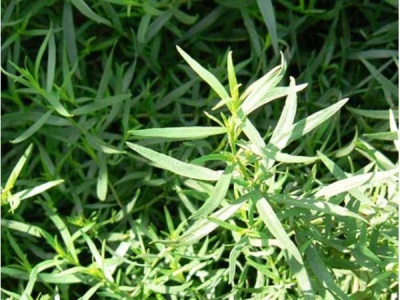
Other plant names are:
- Artemisia dracunculus (lat.)
- Dragon, Bertram (German)
- tarragon, dragon on sagewort
- estragon, dragan, herbe dragonne (fr.)
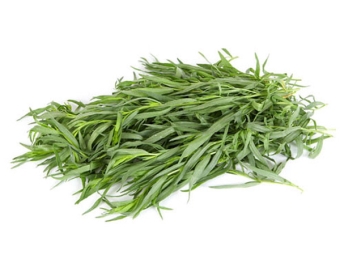

Appearance
Outwardly, tarragon is a bit like the wormwood we are used to: it has a straight, long stem and characteristic oblong, narrow leaves without cuttings.

The height of the plant can reach one and a half meters. In late summer - early autumn, tarragon blooms. Its flowers are small, pale yellow, collected in small panicles.
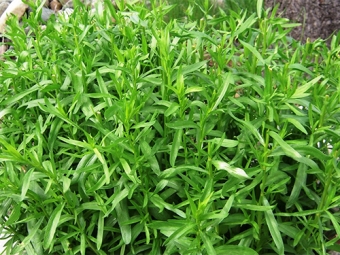
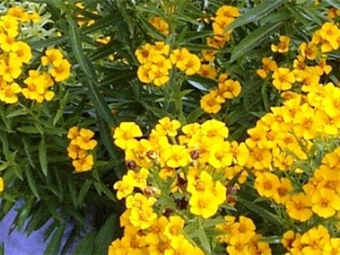
Kinds
There are the following types of tarragon:
- Russian - the flowers of this species are pale green, and the stem and leaves are more massive. It has a strong, rich aroma. It is mainly eaten fresh.
- French - a plant with a thin stem and small leaves. It has a light, spicy aroma, and therefore is valued by culinary specialists more than other types.
- Ordinary - This is a large plant with irregularly shaped leaves. It is distinguished by a rather weak smell and a bitter taste.

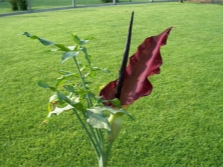

Where does it grow?
Tarragon is widely distributed in Europe, Asia and North America. This herb grows in large quantities in the following countries:
- Mongolia;
- China;
- Pakistan;
- India;
- USA;
- Mexico;
- Canada;
- Russia.
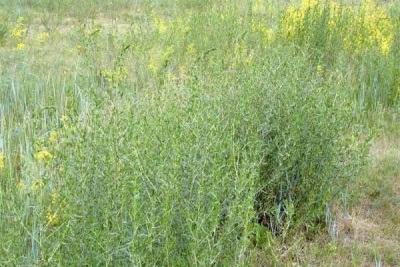
Preparation method
Tarragon begins to be harvested for the winter in August or September, after the first buds appear. The grass is cut at a distance of 10-12 cm from the ground. Cut grass can be tied into bundles, hung on hooks or ropes, and left to dry in a dry, well-ventilated area.
True, many culinary specialists claim that dried grass quickly loses its taste and aroma, so they prefer to make vinegar based on it.

In order to prepare this unusual seasoning, you need:
- Arrange the collected grass in bottles (one stalk per container),
- Fill it with vinegar
- Put in a dark place.
- After two weeks, the vinegar should be filtered and poured into a clean container.


Characteristics
- sharp-spicy taste;
- spicy, tart aroma;
- dark green color.
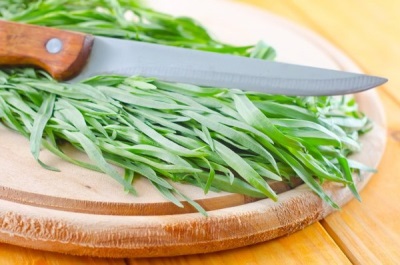
Nutritional value and calories
Nutritional value and calorie content of 100 grams of dry product
| Squirrels | Fats | Carbohydrates | calories |
|---|---|---|---|
| 22.77 gr. | 7.24 gr. | 50.22 gr. | 295 kcal |
Chemical composition
Chemical composition of 100 grams of dry product
| vitamins | Micro and macro elements | ||
|---|---|---|---|
| Vitamin A | 0.1 mg | Calcium | 40 mg |
| Vitamin PP | 0.5 mg | Magnesium | 30 mg |
| Vitamin B1 | 0.03 mg | Sodium | 70 mg |
| Vitamin B2 | 0.03 mg | Potassium | 260 mg |
| Vitamin C | 10 mg | Phosphorus | 50 mg |
| Vitamin PP | 0.7 mg | Iron | 0.5 mg |
| Iodine | 9 mcg |
Beneficial features
- strengthens the immune system;
- is a source of vitamin C and antioxidants;
- normalizes the work of the gastrointestinal tract;
- improves metabolism;
- enhances potency;
- normalizes the menstrual cycle;
- relieves stress and calms the nervous system;
- has anthelmintic action;
- relieves inflammation.

Contraindications
- the use of excessively large doses may be accompanied by symptoms of acute poisoning: nausea, vomiting, loss of consciousness and convulsions;
- tarragon is strictly forbidden to use by pregnant women, as it can provoke a miscarriage;
- people with peptic ulcer and gastritis are strongly advised to refrain from using it.

Oil
The essential oil obtained from tarragon retains its unique aroma, as well as all the beneficial properties of this plant. The oil is not recommended to be used in its pure form, it is better to dilute it with water or add it to other medicinal products.
Tarragon oil can be taken orally, inhaled, applied to the skin to massage or relieve inflammation. It helps fight muscle and joint pain, certain allergies, constipation, and a slow metabolism.

Juice
Tarragon juice is less popular than spice or essential oil, primarily because it cannot be stored for long. Since ancient times, the fresh juice of this plant has been added to strengthening and tonic drinks. Nowadays, it is used in the production of non-alcoholic carbonated drink "Tarhun".
The juice of this medicinal herb can also be used for medicinal purposes, for example, to relieve inflammation of the gums, as well as a laxative and antipyretic.

Application
In cooking
- it is customary to add fresh leaves and stems to jars when preserving vegetables, fruits, mushrooms and berries;
- with the help of this spicy herb, you can cook savory sauces for meat and fish dishes and salad dressings;
- freshly picked tarragon can be added to vegetable salads;
- dried tarragon is used as a seasoning for meat, poultry, fish and various soups;
- dried and crushed tarragon can be added to baked goods to give it a spicy flavor;
- tarragon is often used to make homemade alcoholic beverages.




Recipes
pickled gherkins
- Pour 0.5 kg of gherkins 2 tbsp. salt and mix.
- Put the vegetables on a towel and hang over a deep container or sink for a couple of hours.
- Put a branch of tarragon in a sterilized 3-liter jar, put the gherkins in the next layer, then half a glass of cocktail onions and a clove of garlic, cut into 4 parts. Then add a little more tarragon, a few black peppercorns, a bay leaf and 3 cloves.
- Add 180-200 g of 9% vinegar to a 3-liter jar, leaving 1 cm to the lid. Roll up the jar and leave in a cool place for 3 weeks.

Homemade lemonade "Tarragon"
- Rinse 200 g of fresh tarragon and tear into large pieces.
- Pour half a glass of chilled boiled water, add fresh juice of 1 lemon and 1 lime.
- Fall asleep 1 tbsp. sugar and mash with a rolling pin, pestle or mojito muddler (you can beat all the ingredients in a blender).
- Strain the juice and add 4 parts of water to it.
- Add sugar if necessary. Before serving, pour ice into glasses, add 1 tsp. honey and garnish with mint leaves.

In medicine
Tarragon can be used as an aid to combat the following types of ailments:
- acute respiratory diseases;
- pneumonia;
- tuberculosis;
- bronchitis;
- insomnia;
- violation of the menstrual cycle;
- loss of appetite;
- toothache;
- headache;
- indigestion;
- vascular diseases;
- depression;
- overwork;
- impotence.
For medicinal purposes, tarragon essential oil, fresh plant juice, and various decoctions based on dried herbs are used.
When losing weight
Nutritionists often recommend using tarragon instead of salt for people suffering from various diseases of the kidneys and urinary tract. In addition to adding spicy, spicy notes to food, tarragon is able to remove excess fluid from the body.
cultivation
Before planting, the soil should be fertilized, loosened and well moistened. Sprouts or seeds are laid in holes at a distance of not less than 0.5 m from each other. The seeds are lightly sprinkled with soil, and the seedlings are deepened by about 8 cm.
Tarragon should be watered about 2 times a week. Every 3 months it is necessary to feed the plant with a fertilizer containing superphosphate, potassium sulfate and urea. When the grass reaches 20 cm in height, you can begin to cut it and harvest it for the winter.
Before cold weather, the stem is cut off, leaving 5-6 cm above the ground. You can dig a plant out of the ground, plant it in a pot and grow it at home as a houseplant.
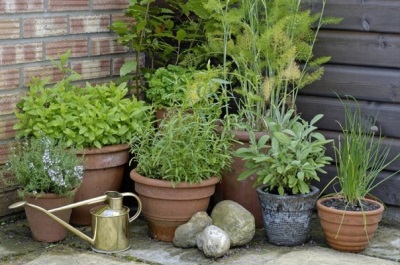
seeds
On a personal plot, tarragon can be grown directly from seeds. Seeds can be sown in the fall "under the snow" or in the spring. Seedlings are planted after the snow melts and the ground begins to thaw.
In the Non-Black Earth Region, tarragon does not sprout from seeds, so seedlings must first be grown. To do this, the seeds are planted in containers at a distance of 5 centimeters from each other. Seedlings will be ready for planting in the ground in two months.
In the markets and shops you can find seeds of various varieties.
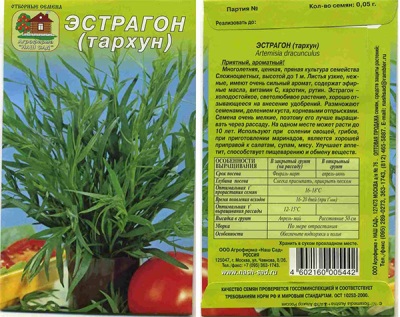
Interesting Facts
- The Latin name for tarragon is Artemisia dracunculus. According to legend, the first word is associated with the name of the Greek goddess Artemis, and the second - with the dragon. In Russia, this plant is called "dragon-grass", and in Poland "wormwood-dragon".Associations with a mythical creature arise due to the shape of the leaf, reminiscent of a forked dragon tongue.
- In ancient times, people chewed fresh tarragon leaves to freshen their breath and relieve toothaches.
- Top perfumers use tarragon to create fragrances.
- Grilled meat lovers can use an tarragon brush to glaze the meat.



Watch the video of the TV show "Life is great!" - learn about the benefits and uses of tarragon a lot of interesting things.


















In general, most herbs speed up metabolism and improve metabolic processes in the body. You must use them in your diet.